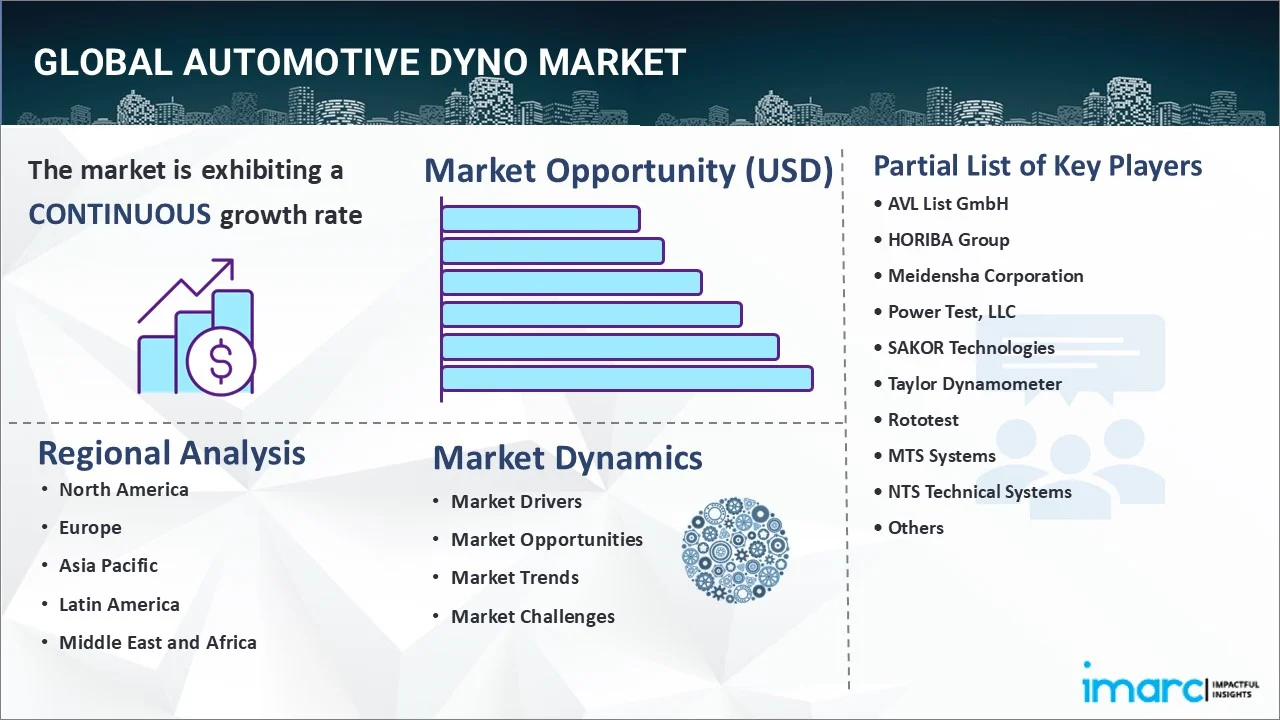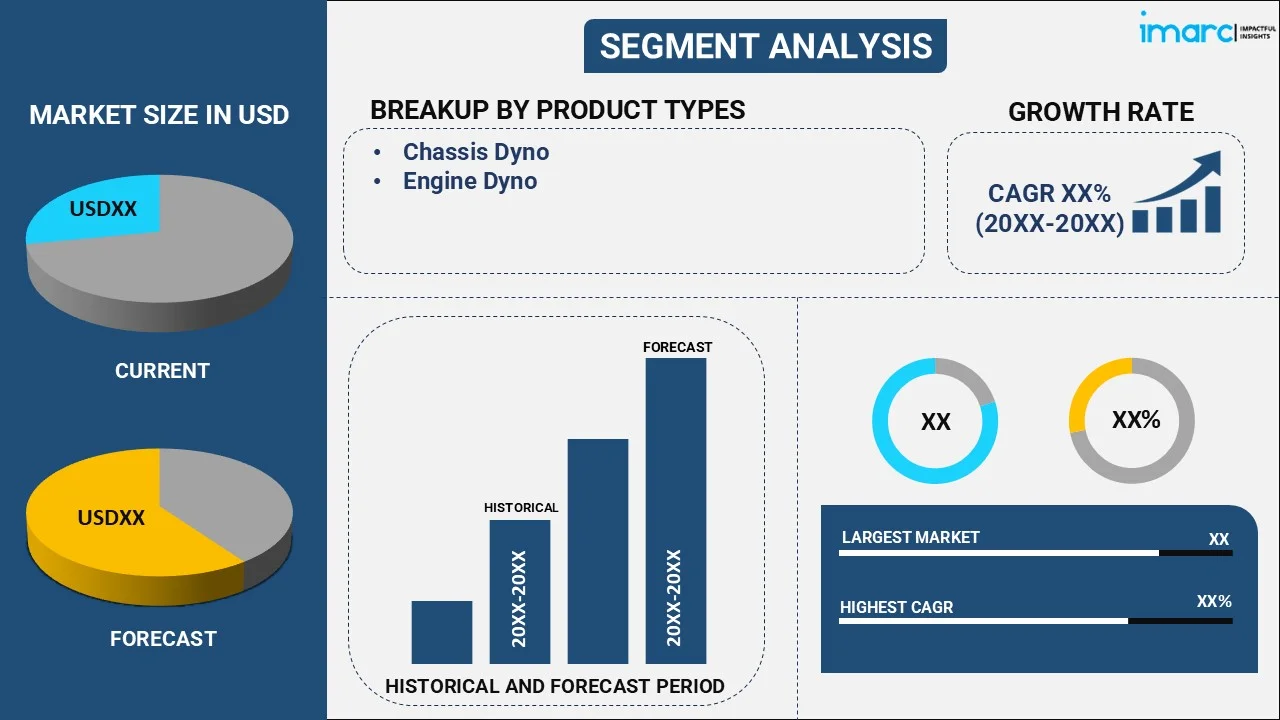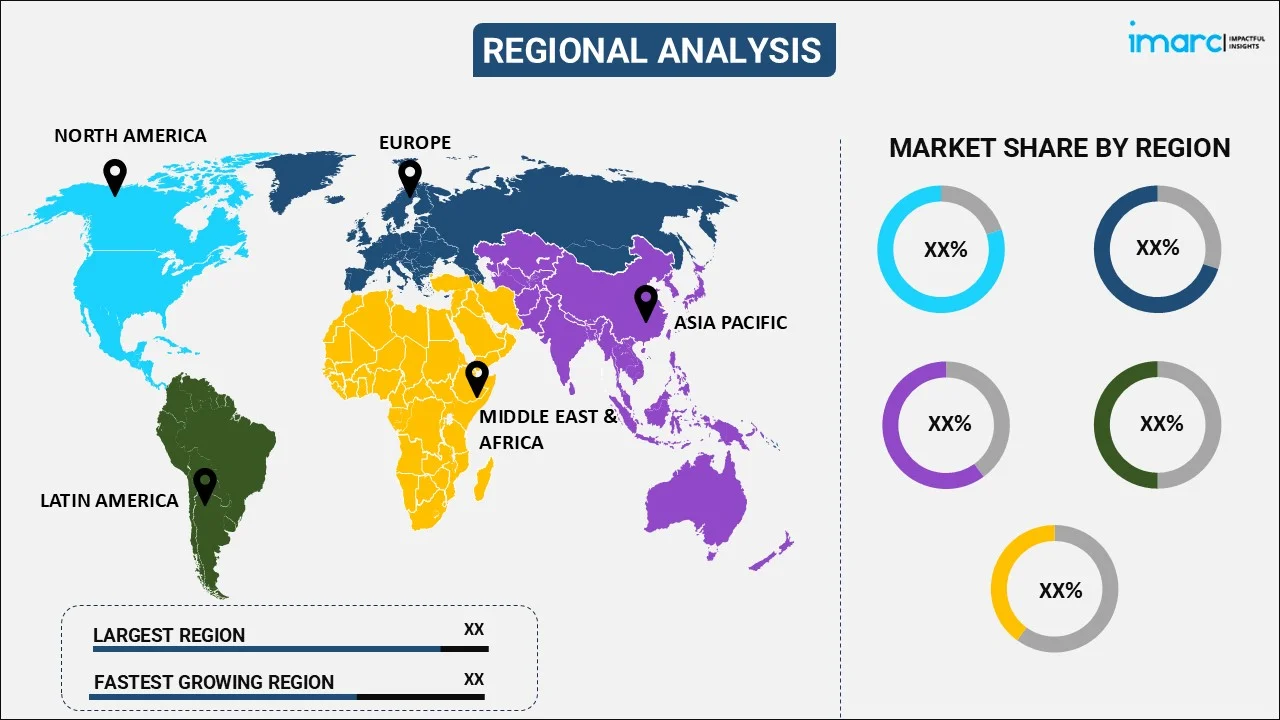
Automotive Dyno Market Report by Product Type (Chassis Dyno, Engine Dyno), Application (Automotive OEM, Automotive Aftermarket), and Region 2025-2033
Market Overview:
The global automotive dyno market size reached USD 912.4 Million in 2024. Looking forward, IMARC Group expects the market to reach USD 1,067.6 Million by 2033, exhibiting a growth rate (CAGR) of 1.76% during 2025-2033. The escalating automobile production and sales, strict government regulations regarding fuel efficiency and vehicular emissions, and increasing applications of automotive dyno across diverse industries represent some of the key factors driving the market.
|
Report Attribute
|
Key Statistics
|
|---|---|
|
Base Year
|
2024
|
|
Forecast Years
|
2025-2033
|
|
Historical Years
|
2019-2024
|
|
Market Size in 2024
|
USD 912.4 Million |
|
Market Forecast in 2033
|
USD 1,067.6 Million |
| Market Growth Rate 2025-2033 | 1.76% |
An automotive dyno, also known as an automotive dynamometer, refers to test equipment designed to measure and record mechanical parameters, such as force, power, torque, and speed, of a vehicle’s engine, motor, or other rotating prime movers simultaneously. It is commonly available in two types, namely engine dyno and chassis dyno. While the engine dyno performs engine testing and measures the power and torque directly from the engine, the chassis dyno analyzes the output of the same at the drive wheels. Besides calculating rotational speed (RPM), accelerations of rollers, resistance generated by electromagnetic brakes, fuel consumption, and emissions of a vehicle, this testing device also finds application in measuring air to fuel ratio (AFR) of a mixture, exhaust gas temperature (EGT), and manifold absolute pressure (MAP). As a result, the automotive dyno is extensively utilized throughout the manufacturing cycle, making it an essential tool for all vehicle assembly lines.

To get more information on this market, Request Sample
Automotive Dyno Market Trends:
Significant expansion in the automotive industry due to the rising automobile production and sales and the augmenting demand for vehicle restoration and refurbishment represent the primary factors supporting the market growth. Apart from this, rapid urbanization and industrialization in both developed and developing nations have accelerated the adoption of vehicles for daily commutation and transportation of goods and raw materials across different locations. Additionally, with the implementation of stringent fuel efficiency regulations and emission norms by governments of various countries, there is a surge in the need for automobiles to undergo compliance tests to meet industry standards and ratings. In line with this, the increasing applications of dyno across the aviation, aerospace, and marine sectors to ensure maximum efficiency of vessel and aircraft engines have propelled the market growth. Furthermore, several key players are focusing on product innovations, including the development of engine torque pulsation simulation (ETPS) dynamometer, to cater to the evolving requirements of end users. In line with this, the rising adoption of automation processes, such as engine mounting test bed and crank angle position detection, has fueled the market growth. Other factors, including the escalating sales of passenger cars owing to the expanding middle-class population and inflating consumer purchasing power, rising preference for electric vehicles (EVs), increasing demand for luxury and high-performance cars, and continual technological advancements, are also expected to provide a positive impact on market growth in the upcoming years.
Key Market Segmentation:
IMARC Group provides an analysis of the key trends in each sub-segment of the global automotive dyno market report, along with forecasts at the global and regional level from 2025-2033. Our report has categorized the market based on product type and application.
Product Type Insights:

- Chassis Dyno
- Engine Dyno
The report has provided a detailed breakup and analysis of the automotive dyno market based on the product type. This includes chassis dyno and engine dyno. According to the report, chassis dyno represented the largest segment.
Application Insights:
- Automotive OEM
- Automotive Aftermarket
A detailed breakup and analysis of the automotive dyno market based on the application has also been provided in the report. This includes automotive OEM and automotive aftermarket. According to the report, automotive OEM accounted for the largest market share.
Regional Insights:

- Asia Pacific
- Europe
- North America
- Middle East and Africa
- Latin America
The report has also provided a comprehensive analysis of all the major regional markets, which include Asia Pacific, Europe, North America, Middle East and Africa, and Latin America. According to the report, Asia Pacific was the largest market for automotive dyno. Some of the factors driving the Asia Pacific automotive dyno market included the presence of a large number of automotive test equipment key suppliers, strict government norms, rising automobile production and sales due to inflating consumer expenditure capacities, low manufacturing costs, and availability of cheap labor, etc.
Competitive Landscape:
The report has also provided a comprehensive analysis of the competitive landscape in the global automotive dyno market. Competitive analysis such as market structure, market share by key players, player positioning, top winning strategies, competitive dashboard, and company evaluation quadrant has been covered in the report. Also, detailed profiles of all major companies have been provided. Some of the companies covered include AVL List GmbH, HORIBA Group, Meidensha Corporation, Power Test, LLC, SAKOR Technologies, Taylor Dynamometer, Rototest, MTS Systems, NTS Technical Systems, SuperFlow Dynamometers & Flowbenches, Schenck Process Holding GmbH, SGS SA, Sierra Instruments, Inc., Mustang Advanced Engineering, KAHN & Company Inc., Hofmann Tesys, Froude, Inc., etc. Kindly note that this only represents a partial list of companies, and the complete list has been provided in the report.
Report Coverage:
| Report Features | Details |
|---|---|
| Base Year of the Analysis | 2024 |
| Historical Period | 2019-2024 |
| Forecast Period | 2025-2033 |
| Units | Million USD |
| Segment Coverage | Product Type, Application, Region |
| Region Covered | Asia Pacific, Europe, North America, Latin America, Middle East and Africa |
| Companies Covered | AVL List GmbH, HORIBA Group, Meidensha Corporation, Power Test, LLC, SAKOR Technologies, Taylor Dynamometer, Rototest, MTS Systems, NTS Technical Systems, SuperFlow Dynamometers & Flowbenches, Schenck Process Holding GmbH, SGS SA, Sierra Instruments, Inc., Mustang Advanced Engineering, KAHN & Company Inc., Hofmann Tesys, Froude, Inc. |
| Customization Scope | 10% Free Customization |
| Post-Sale Analyst Support | 10-12 Weeks |
| Delivery Format | PDF and Excel through Email (We can also provide the editable version of the report in PPT/Word format on special request) |
Key Benefits for Stakeholders:
- IMARC’s report offers a comprehensive quantitative analysis of various market segments, historical and current market trends, market forecasts, and dynamics of the automotive dyno market from 2019-2033.
- The research study provides the latest information on the market drivers, challenges, and opportunities in the global automotive dyno market.
- The study maps the leading, as well as the fastest-growing, regional markets. It further enables stakeholders to identify the key country-level markets within each region.
- Porter's five forces analysis assist stakeholders in assessing the impact of new entrants, competitive rivalry, supplier power, buyer power, and the threat of substitution. It helps stakeholders to analyze the level of competition within the automotive dyno industry and its attractiveness.
- Competitive landscape allows stakeholders to understand their competitive environment and provides an insight into the current positions of key players in the market.
Key Questions Answered in This Report
The global automotive dyno market was valued at USD 912.4 Million in 2024.
We expect the global automotive dyno market to exhibit a CAGR of 1.76% during 2025-2033.
The growing application of automotive dyno across various sectors, such as aviation, aerospace, and marine, to ensure the maximum efficiency of vessel engines is primarily driving the global automotive dyno market.
The sudden outbreak of the COVID-19 pandemic had led to the implementation of stringent lockdown regulations across several nations, resulting in the temporary closure of various end use industries for automotive dyno.
Based on the product type, the global automotive dyno market has been segregated into chassis dyno and engine dyno, where chassis dyno currently holds the largest market share.
Based on the application, the global automotive dyno market can be bifurcated into automotive OEM and automotive aftermarket. Currently, automotive OEM exhibits a clear dominance in the market.
On a regional level, the market has been classified into Asia Pacific, Europe, North America, Middle East and Africa, and Latin America, where Asia Pacific currently dominates the global market.
Some of the major players in the global automotive dyno market include AVL List GmbH, HORIBA Group, Meidensha Corporation, Power Test, LLC, SAKOR Technologies, Taylor Dynamometer, Rototest, MTS Systems, NTS Technical Systems, SuperFlow Dynamometers & Flowbenches, Schenck Process Holding GmbH, SGS SA, Sierra Instruments, Inc., Mustang Advanced Engineering, KAHN & Company Inc., Hofmann Tesys, and Froude, Inc.
Need more help?
- Speak to our experienced analysts for insights on the current market scenarios.
- Include additional segments and countries to customize the report as per your requirement.
- Gain an unparalleled competitive advantage in your domain by understanding how to utilize the report and positively impacting your operations and revenue.
- For further assistance, please connect with our analysts.
 Request Customization
Request Customization
 Speak to an Analyst
Speak to an Analyst
 Request Brochure
Request Brochure
 Inquire Before Buying
Inquire Before Buying




.webp)




.webp)












